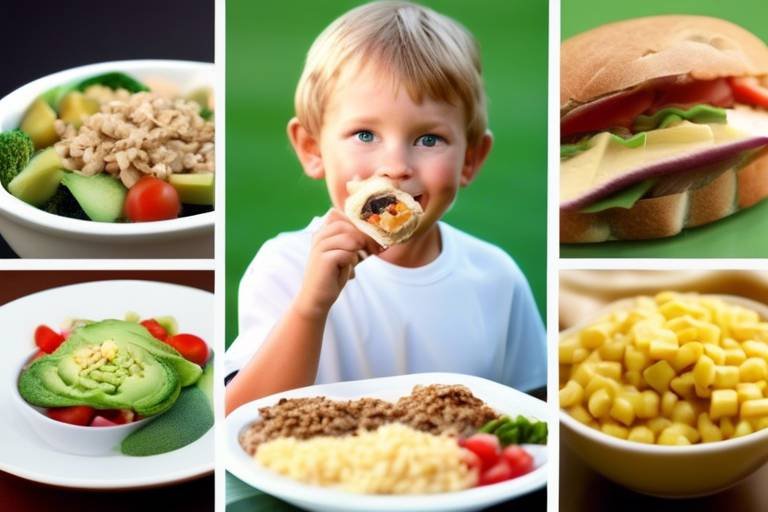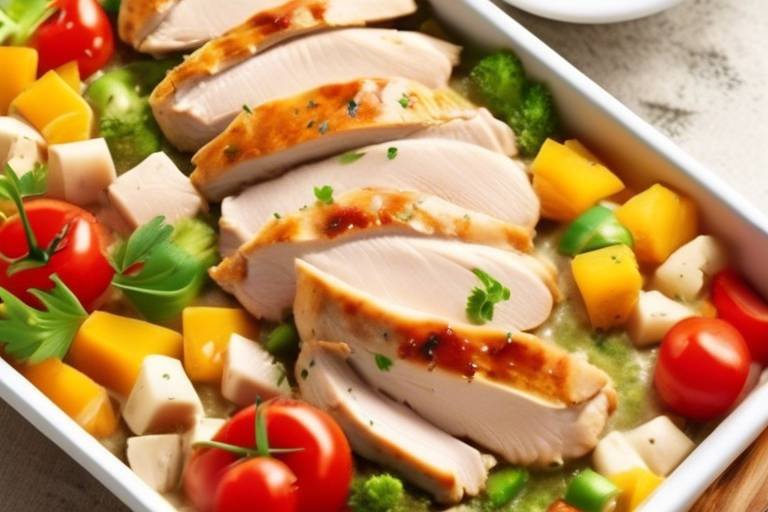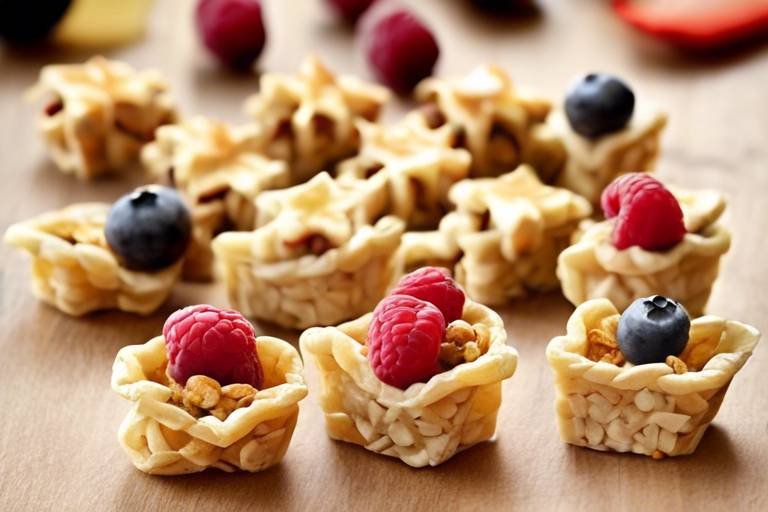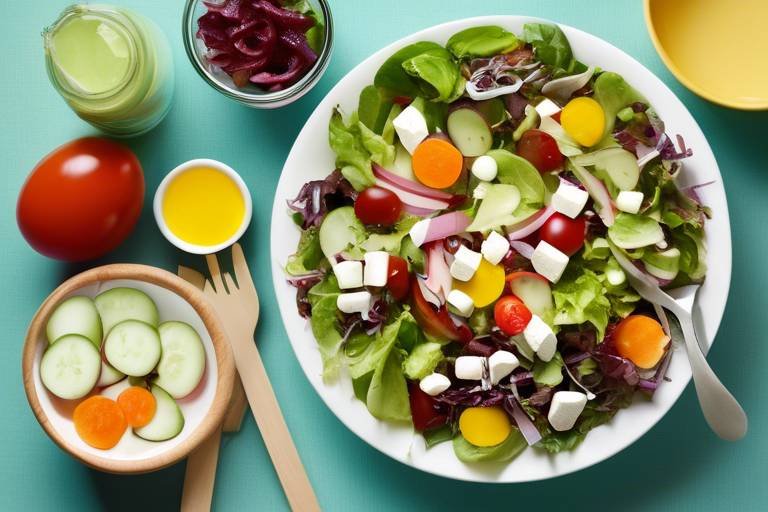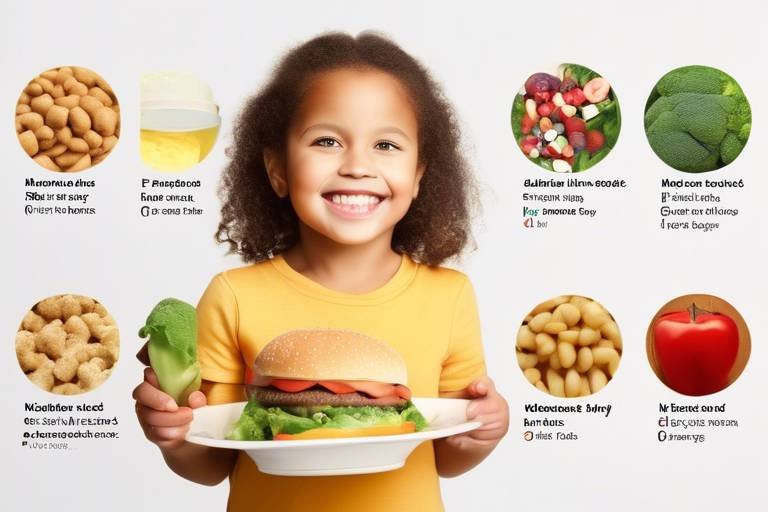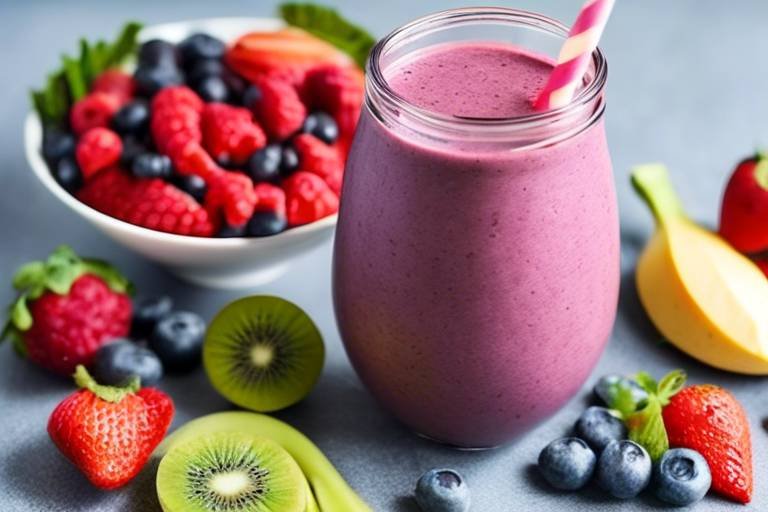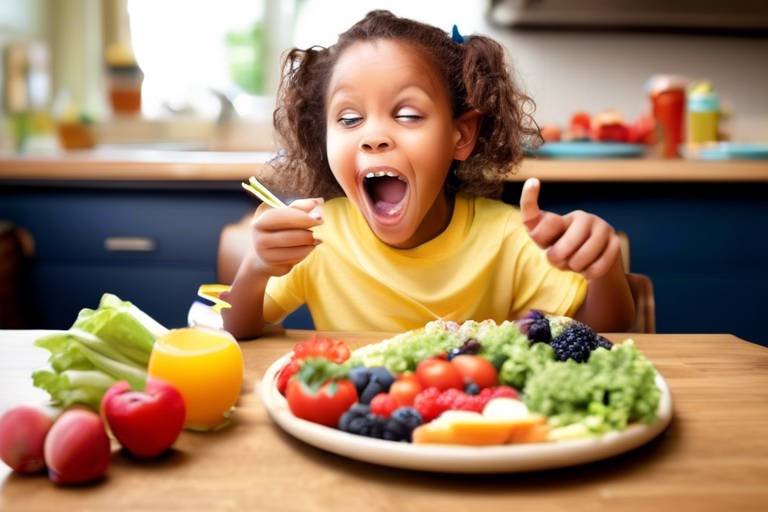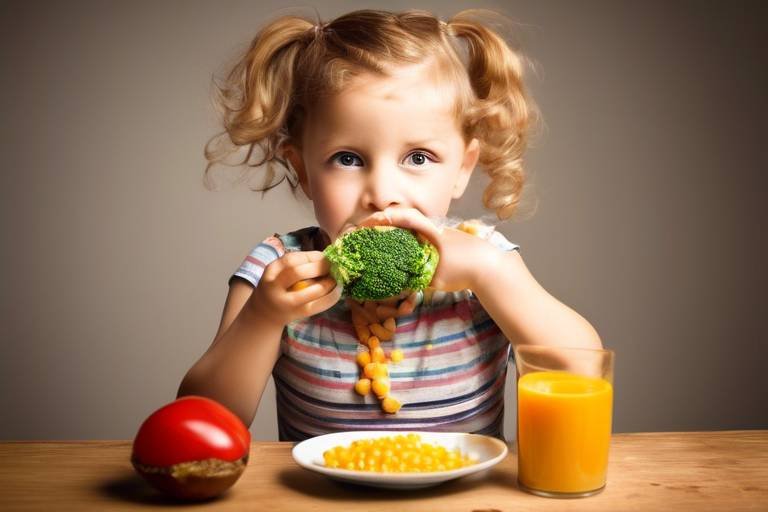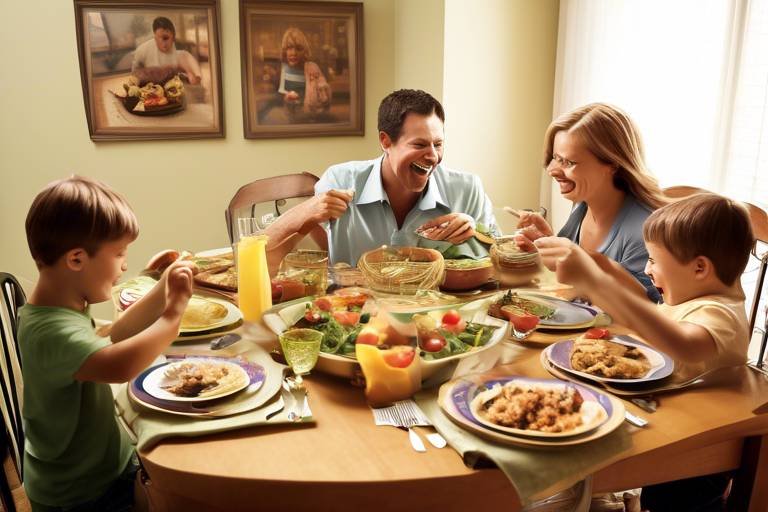Cooking with Toddlers: Easy and Healthy Recipes
Cooking with toddlers can be a delightful adventure in the kitchen! It's not just about whipping up meals; it's about creating memorable experiences that foster healthy eating habits and spark a lifelong interest in food. Imagine the joy on your little one's face as they stir a pot or sprinkle cheese on a pizza! These moments are precious, and they can help your toddler develop a positive relationship with food.
Involving toddlers in the kitchen is a fantastic way to teach them about nutrition. When they participate in cooking, they are more likely to try new foods and appreciate the flavors of fresh ingredients. Plus, cooking together can be a great bonding activity, turning mealtime into a fun family event. Think of it as a mini cooking class where your toddler is the star chef, and you’re the supportive sous-chef!
Moreover, cooking is an excellent opportunity for toddlers to practice their fine motor skills. From pouring ingredients to mixing batter, these activities enhance their dexterity and coordination. As they measure and mix, they are not just helping; they are learning! It’s like giving them a passport to explore the world of flavors, textures, and colors while developing essential skills.
So, what can you cook with your tiny chef? The possibilities are endless! Consider recipes that are simple, nutritious, and, most importantly, fun! Think about colorful fruit kabobs, where toddlers can choose their favorite fruits to create their own edible art. Or veggie pancakes, which are not only delicious but also a sneaky way to introduce vegetables into their diet. The key is to keep it simple and engaging, allowing your toddler to take the lead in the kitchen.
As you embark on this culinary journey with your toddler, remember that the goal is not just to create a meal but to instill a sense of joy and curiosity about food. By making cooking a regular family activity, you are laying the groundwork for healthy eating habits that will last a lifetime. So, roll up those sleeves, put on some aprons, and get ready for a fun-filled cooking experience that your toddler will cherish!
Engaging toddlers in cooking not only fosters their interest in food but also enhances fine motor skills, boosts confidence, and encourages healthy eating habits from an early age.
Discover age-appropriate kitchen tools that make cooking safe and enjoyable for toddlers. These tools help little hands participate in meal preparation with ease and excitement.
Explore various utensils designed specifically for toddlers, such as safe knives, measuring cups, and mixing bowls that are easy to grip and use.
Learn about the importance of colorful cutting boards that attract toddlers and make food preparation more fun and engaging.
Understand how non-slip mats can provide stability while cooking, ensuring safety and preventing messes during food preparation.
Engage toddlers in enjoyable cooking activities that stimulate their creativity and encourage them to explore different ingredients and flavors.
Check out a selection of easy and healthy recipes perfect for cooking with toddlers, featuring simple steps and minimal ingredients that promote hands-on learning.
Learn how to create colorful fruit kabobs that are not only fun to make but also a healthy snack option for toddlers.
Discover a delicious recipe for veggie pancakes that incorporates nutritious ingredients, making it a great way to introduce vegetables to picky eaters.
Find strategies to instill healthy eating habits in toddlers through cooking, emphasizing the importance of balanced meals and the joy of trying new foods.
Explore creative ways to present food that makes healthy eating appealing to toddlers, including fun shapes and colorful presentations.
Learn how involving toddlers in meal planning can help them develop a sense of ownership over their food choices, promoting healthier eating habits.
- What age can toddlers start cooking? Most toddlers can start helping in the kitchen as young as 2 or 3 years old, with supervision.
- Are there any safety tips for cooking with toddlers? Always supervise them closely, use kid-safe utensils, and keep sharp objects and hot surfaces out of reach.
- How can I encourage my toddler to try new foods? Involve them in the cooking process and present food in fun, creative ways to make it more appealing.

Benefits of Cooking with Toddlers
Engaging toddlers in the kitchen is more than just a fun activity; it’s a gateway to numerous developmental benefits. When you invite your little ones to help with cooking, you’re not just stirring up a delicious meal; you’re also stirring up their curiosity and creativity. Imagine the joy on their faces as they mix ingredients, taste-test, and see the transformation from raw to cooked food! This hands-on experience is crucial for their growth.
One of the most significant advantages of cooking with toddlers is the enhancement of their fine motor skills. Tasks such as pouring, mixing, and cutting (with safe utensils, of course) require coordination and control, which helps strengthen their hand muscles. As they practice these skills, they gain confidence in their abilities. This newfound confidence can translate into other areas of their lives, such as writing and drawing. Isn’t it amazing how a simple act like cooking can have such a profound impact?
Moreover, involving toddlers in the kitchen encourages them to develop healthy eating habits from an early age. When children participate in the cooking process, they become more interested in the food they eat. They learn about different ingredients, where they come from, and how they contribute to a balanced diet. This knowledge is invaluable as it lays the foundation for lifelong healthy eating patterns. You might be surprised to see a picky eater willingly try a new vegetable just because they helped prepare it!
Cooking together also creates opportunities for quality family bonding. Picture this: laughter fills the air as flour flies everywhere during a baking session. These moments not only create lasting memories but also foster a sense of teamwork and cooperation. As you navigate the kitchen chaos together, you’re teaching your toddlers important social skills like sharing, patience, and communication. Plus, it’s a fantastic way to spend time together away from screens and distractions!
Lastly, cooking can be a wonderful way to introduce toddlers to math and science concepts. Measuring ingredients teaches them about quantities and fractions, while observing how heat changes food can spark their interest in science. It’s a deliciously fun way to incorporate learning into everyday activities. Who knew that making cookies could also be a lesson in chemistry?
In summary, the benefits of cooking with toddlers are vast and varied. From improving fine motor skills to promoting healthy eating habits and enhancing family bonds, every moment spent in the kitchen is an investment in their development. So, why not roll up your sleeves and dive into the delightful world of cooking with your little ones? The kitchen is a magical place where learning and fun go hand in hand!

Essential Kitchen Tools for Toddlers
When it comes to cooking with toddlers, having the right tools is essential. Not only do these tools make the cooking process easier, but they also ensure that little hands can safely participate in the fun. Imagine your toddler, with their tiny hands gripping a colorful spatula, eagerly helping you mix ingredients. It's a delightful sight that not only fosters their interest in food but also builds their confidence. So, what are the must-have kitchen tools for your little chefs? Let's dive in!
First and foremost, kid-friendly utensils are a game changer. These specially designed tools are not only safe but also perfectly sized for toddlers. Think about safe knives with rounded edges that allow your child to chop soft fruits without the risk of injury. Measuring cups and mixing bowls that are easy to grip can transform the cooking experience into a fun adventure. Your toddler will love measuring out ingredients, feeling like a real chef in the kitchen!
Another essential tool is the colorful cutting board. Bright colors can attract toddlers' attention and make food preparation more engaging. Instead of a plain wooden board, opt for vibrant, washable cutting boards. They can even serve as a canvas for your child’s creativity—how about letting them arrange their chopped vegetables into a fun shape? It’s a simple way to encourage them to explore their culinary skills while making the process visually appealing.
Safety is paramount, and that’s where non-slip mats come into play. These mats provide stability while cooking, preventing slips and spills that can happen when little feet get too excited. Place them under mixing bowls or cutting boards to keep everything in place. This not only ensures safety but also minimizes mess, allowing you and your toddler to focus on the joy of cooking together.
Engaging toddlers in the kitchen can also involve various fun cooking activities. Encourage them to help wash vegetables, sprinkle cheese on a pizza, or even roll out dough. These activities not only enhance their fine motor skills but also allow them to explore different ingredients and flavors. Imagine the pride on their faces when they see the tasty results of their hard work!
In summary, equipping your kitchen with the right tools can make cooking with toddlers a joyous experience. From kid-friendly utensils to colorful cutting boards and non-slip mats, each tool plays a vital role in creating a safe and enjoyable cooking environment. So gather your little ones, grab these essential tools, and embark on a culinary adventure that promises to be both fun and educational!

Kid-Friendly Utensils
When it comes to cooking with toddlers, having the right utensils can make all the difference. Not only do ensure safety, but they also empower little ones to participate actively in the kitchen. Imagine your toddler, beaming with pride as they help mix batter or cut fruits with their very own tools! It's a beautiful sight that fosters independence and builds confidence.
First up, let’s talk about safe knives. Yes, you heard that right! There are specially designed knives that are perfect for tiny hands. These knives often have rounded edges and are made from materials that are less likely to cause injury. They allow toddlers to practice their cutting skills on soft fruits and vegetables, like bananas and cucumbers, making the experience both safe and enjoyable.
Next, measuring cups and spoons are not just for adults! Kid-friendly measuring tools are often vibrant in color and made from lightweight materials, making them easy for toddlers to handle. Not only do they get to learn about measurements, but they also get to explore the concept of volume by pouring and scooping different ingredients. This hands-on experience can spark a love for cooking that lasts a lifetime!
Mixing bowls are another essential tool in the toddler kitchen. Look for bowls that are designed with non-slip bottoms. These bowls stay put while your little chef stirs and mixes, preventing spills and messes. Plus, many come in fun colors or with cute designs that make the cooking process even more exciting!
To sum it up, here are some must-have kid-friendly utensils:
- Safe Knives: Rounded edges for safe cutting.
- Measuring Cups and Spoons: Lightweight and colorful for easy handling.
- Mixing Bowls: Non-slip bottoms to prevent messes.
By equipping your kitchen with these essential tools, you’re not only making cooking safer for your toddler but also turning meal prep into a fun and educational experience. Remember, the goal is to make cooking a delightful activity that encourages creativity and curiosity about food. So, let those little hands get involved and watch as they discover the joy of cooking!

Colorful Cutting Boards
When it comes to cooking with toddlers, can transform a mundane task into a vibrant adventure! These boards are not just visually appealing; they serve several practical purposes that make cooking safer and more enjoyable for little ones. Imagine your toddler's eyes lighting up at the sight of a bright red or sunny yellow cutting board—it's like inviting them into a world of culinary creativity!
One of the primary benefits of using colorful cutting boards is that they can help differentiate between various food types. For instance, you might choose a green board for veggies and a red one for fruits. This not only teaches toddlers about food but also instills the importance of hygiene and cross-contamination prevention in a fun way. You can even make a game out of it—ask your child to find the right board for each ingredient, turning the kitchen into a playful learning environment!
Moreover, the bright colors can stimulate a toddler's senses and encourage them to engage more actively in the cooking process. When children are excited about their surroundings, they are more likely to participate enthusiastically. The vibrant hues can also serve as a backdrop for storytelling—"Let’s chop our apples on the green board, just like the frogs in our storybook!" This kind of imaginative play enhances their overall experience and keeps them interested.
In addition to aesthetics, many colorful cutting boards are made from durable, child-safe materials that are easy to clean. Look for boards that are non-toxic and BPA-free, ensuring that your little chef is safe while they explore their culinary skills. Some boards even come with fun shapes or designs, making them not just functional but also a delightful addition to your kitchen.
So, if you’re looking to make cooking with your toddler more engaging, consider investing in a set of colorful cutting boards. They are not just tools; they are gateways to creativity, learning, and fun! Plus, they make for great conversation starters during meal prep. Remember, cooking together is about bonding and creating memories, and colorful cutting boards can make that experience even sweeter.

Non-Slip Mats
When it comes to cooking with toddlers, safety is paramount. One of the best ways to ensure a secure cooking environment is by using . These mats provide a stable surface, preventing slips and falls that can occur when little feet are darting around the kitchen. Imagine your toddler excitedly helping you mix ingredients, only to lose their balance on a slippery floor. With non-slip mats, that scenario becomes a thing of the past!
Non-slip mats are designed to grip the floor, offering excellent traction. They come in various materials, including rubber and silicone, which are both effective at keeping the mat in place. This means that when your toddler is kneading dough or stirring a pot, they can focus on the fun of cooking rather than worrying about slipping. Plus, many non-slip mats are easy to clean, making them a practical choice for any busy kitchen.
Not only do they enhance safety, but non-slip mats can also help in reducing mess during food preparation. Toddlers can be quite the little chefs, and spills are almost inevitable. A non-slip mat can catch those spills, making clean-up a breeze. Just think of it as a safety net for your culinary adventures! You can easily wipe down the mat after each cooking session, ensuring that your kitchen remains tidy and hygienic.
Furthermore, non-slip mats can add a splash of color and fun to your kitchen space. Available in various designs and patterns, these mats can appeal to your toddler's sense of style, making them more eager to participate in cooking activities. Whether you choose bright colors or playful designs, these mats can help create an inviting atmosphere that encourages your little ones to explore their culinary skills.
In conclusion, investing in non-slip mats is a small but significant step towards creating a safe and enjoyable cooking experience for toddlers. They provide stability, reduce mess, and can even brighten up your kitchen. So, before you start your next cooking adventure with your little one, make sure you have a reliable non-slip mat in place!
- What are non-slip mats made of? Non-slip mats are typically made from materials like rubber or silicone, which provide excellent grip on the floor.
- Are non-slip mats easy to clean? Yes, most non-slip mats are designed to be easy to clean, making them practical for busy kitchens.
- Can non-slip mats help reduce mess? Absolutely! They can catch spills and make clean-up much simpler.
- Do non-slip mats come in different designs? Yes, they are available in various colors and patterns, making them visually appealing for toddlers.

Fun Cooking Activities
Cooking with toddlers is not just about making food; it’s about creating lasting memories and sparking a sense of adventure in the kitchen! Imagine the excitement on their little faces as they mix, stir, and taste. Engaging toddlers in fun cooking activities can transform a simple meal prep into a delightful experience that fuels their curiosity and creativity. Here are some exciting activities that will keep your little chefs entertained and involved!
One fantastic activity is to set up a mini pizza-making station. Gather a variety of toppings such as cheese, vegetables, and sauces, and let your toddlers create their own masterpieces. This not only allows them to express their creativity but also gives them a sense of ownership over their meal. You can even make it a themed night, like “Taco Tuesday” or “Pizza Friday,” to add a fun twist!
Another engaging activity is to organize a fruit and veggie art session. Provide an array of colorful fruits and vegetables, and encourage your toddlers to create fun shapes or faces. Use cookie cutters to make star-shaped cucumbers or heart-shaped strawberries. This not only makes healthy eating visually appealing but also encourages them to try new foods in a playful way!
Additionally, consider hosting a taste-testing party. Prepare small samples of different fruits, vegetables, or dips, and let your toddlers taste and rate them. This can be an exciting way for them to explore new flavors and textures while developing their palates. You can even create a chart to keep track of their favorites, which adds an element of fun and learning!
To make these activities even more interactive, you can incorporate songs and rhymes related to cooking. Singing while you cook can create a lively atmosphere and make the experience even more enjoyable. Plus, it’s a great way to enhance their language skills and make learning fun!
Finally, don’t forget to celebrate your cooking adventures! After completing your meal, have a little family feast where everyone shares what they enjoyed about the cooking process. This not only reinforces their involvement but also creates a positive association with preparing and eating healthy foods. So, roll up those sleeves, put on some aprons, and dive into the wonderful world of cooking with your toddlers!
Q: What age should I start cooking with my toddler?
A: You can start involving your toddler in the kitchen as early as 2-3 years old, depending on their interest and ability. Simple tasks like washing vegetables or stirring ingredients can be a great start!
Q: What are some safe kitchen tools for toddlers?
A: Look for age-appropriate utensils like plastic knives, measuring cups, and mixing bowls designed for small hands. These tools help ensure safety while making cooking fun.
Q: How can I encourage my toddler to try new foods?
A: Involve them in the cooking process and make it fun! Use creative presentations, like food art, and offer taste-testing opportunities to encourage them to explore new flavors.
Q: Are there any cooking activities that are particularly good for fine motor skills?
A: Yes! Activities like pouring, mixing, and using cookie cutters can significantly enhance fine motor skills while keeping toddlers engaged in the cooking process.

Simple Recipes to Try
When it comes to cooking with toddlers, simplicity is key! You want recipes that are not only easy to follow but also exciting for little hands to help with. Here are a couple of delightful recipes that will keep your toddlers engaged while sneaking in some healthy ingredients. Grab your aprons and let’s dive into the kitchen!
Fruit kabobs are a fantastic way to introduce your toddlers to a variety of fruits in a fun and interactive way. They can choose their favorite fruits, practice their fine motor skills by threading them onto skewers, and enjoy a healthy snack afterward. Here’s how you can make them:
- Ingredients: Choose a mix of colorful fruits such as strawberries, bananas, grapes, and melon.
- Equipment: Child-safe skewers or wooden sticks.
First, wash and cut the fruits into bite-sized pieces. Then, let your little ones pick and thread the fruits onto the skewers. You can even create patterns or rainbow designs to make it more exciting! Not only is this a great way to get them involved, but it also encourages them to try new fruits they might not typically eat.
Veggie pancakes are another excellent recipe that can turn your picky eater into a veggie lover! They’re fluffy, delicious, and packed with nutrients. Here’s a simple recipe you can follow:
- Ingredients:
- 1 cup of grated zucchini
- 1 cup of grated carrots
- 1 cup of flour
- 1 egg
- 1 cup of milk
- Salt and pepper to taste
- Instructions:
- In a large bowl, mix the grated zucchini and carrots with flour, egg, milk, salt, and pepper.
- Heat a non-stick skillet over medium heat and pour a small amount of the batter to form pancakes.
- Cook until bubbles form on the surface, then flip and cook until golden brown.
Let your toddlers help with mixing the ingredients and pouring the batter into the pan. They’ll love seeing their creations come to life! Serve these pancakes with a dollop of yogurt or a drizzle of honey for added flavor. It’s a win-win!
Cooking with your toddlers doesn’t just have to be about following recipes; it can also be an opportunity for them to express their creativity. Encourage them to come up with their own combinations of fruits and veggies or even create their unique dishes. This not only makes cooking fun but also helps them take ownership of their meals and fosters a love for healthy eating!
Q: What age can my toddler start helping in the kitchen?
A: Generally, toddlers as young as two years old can start helping with simple tasks like washing fruits and veggies. As they grow, you can involve them in more complex activities.
Q: Are there any safety tips I should keep in mind?
A: Absolutely! Always supervise your toddlers closely while cooking. Use child-safe utensils and ensure they’re away from hot surfaces. Teaching them about kitchen safety is crucial!
Q: How can I make cooking more appealing to my toddler?
A: Make it a game! Use colorful ingredients, let them choose what to cook, and involve them in the entire process. You can even create fun themes for each cooking session!
Cooking with toddlers is an adventure filled with laughter, learning, and deliciousness. So, roll up your sleeves, get messy, and have a blast in the kitchen!

Fruit Kabobs
Creating is not just a fun activity; it's also a fantastic way to introduce your toddler to the world of healthy eating! These colorful skewers are visually appealing and can be customized to suit your child’s taste preferences. Plus, they’re a great way to sneak in a variety of fruits, which are essential for a balanced diet. You can think of fruit kabobs as edible art—each skewer becomes a canvas for your little one’s creativity!
To make fruit kabobs, you’ll need a few simple ingredients: fresh fruits, skewers (make sure they're toddler-safe), and perhaps some yogurt or honey for dipping. The beauty of this recipe lies in its versatility. You can use whatever fruits you have on hand, such as strawberries, bananas, grapes, and pineapple. Not only do these fruits provide essential vitamins and minerals, but they also offer a burst of flavor that’s sure to excite your toddler’s taste buds.
Here’s a quick guide to help you assemble your fruit kabobs:
- Choose Your Fruits: Let your toddler pick their favorite fruits. This involvement makes them more likely to eat what they help create.
- Prep the Fruits: Wash and cut the fruits into bite-sized pieces. Ensure that any larger fruits are cut small enough for tiny hands to manage.
- Skewer the Fruits: Show your toddler how to thread the fruit pieces onto the skewers. This activity is not only fun but also enhances their fine motor skills.
As you create these delightful kabobs together, you can also talk about the different colors and shapes of the fruits, making it a fun learning experience. For example, you might say, “Look at how bright and red the strawberries are! Do you know they are rich in vitamin C?” This kind of dialogue not only keeps them engaged but also helps them understand the importance of nutrition.
Once your kabobs are ready, you can serve them with a side of yogurt or a drizzle of honey for dipping. This adds an extra layer of flavor and makes the experience even more enjoyable. You can even turn it into a mini party by inviting friends over for a “fruit kabob making day.” Imagine the laughter and joy as toddlers create their own unique combinations!
In conclusion, fruit kabobs are more than just a snack; they are a wonderful way to bond with your toddler while instilling healthy eating habits. So, roll up your sleeves, grab those skewers, and let the fruity fun begin!
1. Can I use frozen fruits for kabobs?
Yes, you can! However, make sure to thaw them properly and drain any excess moisture to prevent sogginess.
2. What age is appropriate for toddlers to help with fruit kabobs?
Typically, toddlers aged 2 and up can participate in this activity under supervision, especially with safe utensils.
3. How can I make fruit kabobs more exciting?
Try using cookie cutters to create fun shapes with the fruits or include a variety of dips like chocolate sauce or peanut butter!
4. Are there any fruits I should avoid?
Avoid fruits that are choking hazards for toddlers, such as whole grapes or large chunks of apples. Always cut fruits into manageable sizes.

Veggie Pancakes
Veggie pancakes are a fantastic way to sneak in some nutrition while having a blast in the kitchen with your little ones! These pancakes are not only colorful and appealing, but they also pack a punch of vitamins and minerals. Imagine a plate filled with vibrant greens, yellows, and reds, enticing your toddler to dive right in. Cooking these pancakes together can turn a simple meal into a fun and educational experience, teaching your child about the importance of vegetables in a healthy diet.
To make veggie pancakes, you don’t need to be a master chef. The beauty of this recipe lies in its simplicity and flexibility. You can use a variety of vegetables such as spinach, carrots, zucchini, or bell peppers, depending on what you have at home or what your toddler enjoys. The process is straightforward: just chop the veggies into small pieces and mix them into a batter made from flour, eggs, and a splash of milk. The fun part? Letting your toddler stir the mixture! Their little hands will be excited to mix and see how the colors blend together.
Here’s a quick overview of how to prepare these delightful pancakes:
| Ingredient | Quantity |
|---|---|
| All-purpose flour | 1 cup |
| Eggs | 2 |
| Milk | 1/2 cup |
| Chopped veggies (spinach, carrots, etc.) | 1 cup |
| Baking powder | 1 tsp |
| Salt | To taste |
Once you have your ingredients ready, follow these simple steps:
- Mix the dry ingredients: In a large bowl, combine the flour, baking powder, and salt.
- Whisk the wet ingredients: In another bowl, beat the eggs and then stir in the milk.
- Combine: Pour the wet ingredients into the dry ingredients and mix until just combined. Gently fold in the chopped veggies.
- Cook: Heat a non-stick skillet over medium heat, pour in a ladle of batter, and cook until bubbles form on the surface. Flip and cook until golden brown.
Serving these pancakes can be a creative adventure too! You can cut them into fun shapes using cookie cutters or stack them high for a pancake tower. Serve with a dollop of yogurt or a drizzle of honey for added sweetness. Not only will your toddler enjoy the taste, but they’ll also feel proud of their culinary creation. Plus, it’s a sneaky way to get them to eat their veggies!
So, next time you're looking for a way to involve your toddler in the kitchen, give these veggie pancakes a try. They’re not just a meal; they’re a memory in the making, filled with laughter, learning, and the joy of cooking together. And who knows? You might just create a little chef who loves veggies!
Q: Can I use frozen vegetables for the pancakes?
A: Absolutely! Just make sure to thaw and drain any excess water before mixing them into the batter.
Q: How can I store leftover pancakes?
A: You can store them in an airtight container in the refrigerator for up to three days. They also freeze well; just pop them in the freezer between layers of parchment paper.
Q: Can I make these pancakes gluten-free?
A: Yes! You can substitute the all-purpose flour with a gluten-free flour blend to make them suitable for a gluten-free diet.

Encouraging Healthy Eating Habits
When it comes to instilling healthy eating habits in toddlers, the kitchen can be a magical place. Cooking together not only creates delicious meals but also serves as a fantastic opportunity to teach little ones about nutrition and the importance of balanced diets. Imagine transforming a mundane task into an exciting adventure! By involving your toddler in the cooking process, you can inspire curiosity about different foods and flavors, making them more likely to try new things. It's like turning them into little food explorers on a quest to discover the wonders of healthy eating!
One of the most effective strategies for encouraging healthy eating is to make food fun. This can be achieved through creative presentations. For example, you can use cookie cutters to create fun shapes out of fruits and vegetables, or arrange food in a colorful rainbow pattern on their plates. Not only does this stimulate their visual senses, but it also makes eating an engaging experience. Remember, toddlers are naturally drawn to bright colors and playful designs, so don't hesitate to unleash your inner artist!
Another key aspect is to involve toddlers in meal planning. When children participate in deciding what to cook, they feel a sense of ownership over their meals. This can significantly influence their willingness to try new foods. You might say, "Hey buddy, what do you think we should have for dinner this week?" or "Would you like to help me pick out some veggies at the store?" This simple act of inclusion can empower them and make them more enthusiastic about the meals you prepare together.
As you embark on this culinary journey with your toddler, it’s essential to emphasize the value of balanced meals. You can explain the different food groups in a fun way. For instance, you could say, "We need our superhero proteins to help us grow strong, our colorful fruits and veggies to keep us healthy, and our whole grains to give us energy!" This playful language not only makes the concept of nutrition more relatable but also helps them understand the importance of variety in their diet.
Lastly, don't forget to celebrate small victories! If your toddler tries a new vegetable or helps prepare a meal, make a big deal out of it. Praise their efforts and express how proud you are of them. This positive reinforcement can boost their confidence and encourage them to continue making healthy choices. Cooking is not just about the food; it's about creating lasting memories and cultivating a love for healthy eating that will last a lifetime.
- What are some easy meals to cook with toddlers? Simple meals like fruit kabobs, veggie pancakes, and smoothies are great options!
- How can I make vegetables more appealing to my toddler? Try using fun shapes, colorful presentations, or even dips to make them more enticing.
- At what age can my child start helping in the kitchen? Toddlers as young as 2 years old can help with simple tasks like washing vegetables or stirring ingredients.

Making Food Fun
When it comes to cooking with toddlers, one of the best ways to encourage them to eat healthy is by making food fun! Imagine transforming a simple meal into a vibrant masterpiece that sparks joy and curiosity. Kids are naturally drawn to colors, shapes, and textures, so why not use that to your advantage? By incorporating playful elements into your food preparation, you can create a delightful experience that not only excites their taste buds but also makes them eager to participate in the kitchen.
One effective way to make food fun is through creative presentations. For instance, you can use cookie cutters to shape sandwiches or fruits into fun characters or animals. This not only makes the meal visually appealing but also encourages toddlers to explore their food. You might be surprised at how a simple star-shaped sandwich can turn a mundane lunch into an exciting adventure! Additionally, consider using colorful plates and utensils to enhance the meal's presentation. Bright colors can stimulate a toddler's appetite and make them more interested in what they are about to eat.
Another exciting idea is to create themed meals. For example, you could have a Rainbow Day where every food item on the plate represents a different color of the rainbow. You might include red strawberries, orange carrots, yellow corn, green peas, blue blueberries, and purple grapes. This not only teaches toddlers about different fruits and vegetables but also encourages them to try new flavors. You can even involve them in the planning process—ask them which colors they want to include, and watch their eyes light up as they take ownership of their meal!
Engaging toddlers in cooking activities can also be a great way to make food fun. Let them help with simple tasks like stirring, pouring, or sprinkling toppings. You can create a mini cooking station where they can decorate their own pizzas with various toppings. This hands-on approach not only fosters creativity but also gives them a sense of accomplishment. When they see their culinary creations come to life, they’re more likely to want to eat what they’ve made!
Lastly, don’t forget the power of storytelling! Turn mealtime into a magical experience by weaving tales around the food. For example, you could tell a story about how a brave knight (the broccoli) saves the day by giving everyone super strength. This imaginative approach can transform even the most reluctant eater into an enthusiastic participant. By connecting food with fun narratives, you can create a positive association with healthy eating that lasts a lifetime.
Q: How can I get my toddler interested in cooking?
A: Start with simple tasks and make it a fun activity. Use colorful utensils, create fun shapes with food, and involve them in meal planning. The key is to keep it light and enjoyable!
Q: Are there specific foods that are better for engaging toddlers?
A: Yes! Foods that are colorful, have interesting textures, and can be shaped or decorated (like fruits, veggies, and whole grains) are great for engaging toddlers. Think about how you can make these foods visually appealing.
Q: What if my toddler refuses to try new foods?
A: It’s normal for toddlers to be picky eaters. Encourage them to try new foods by involving them in the cooking process and making it a fun experience. Sometimes, just letting them see, touch, and smell the food can pique their interest!

Involving Toddlers in Meal Planning
Involving toddlers in meal planning can be an exciting and rewarding experience for both parents and children. Imagine the joy on your little one's face when they see their favorite foods being prepared! By allowing toddlers to participate in the planning process, you not only foster their interest in food but also empower them to make choices about what they eat. This can lead to healthier eating habits that last a lifetime. It's like giving them the keys to their own culinary kingdom!
Start by having a fun family meeting where everyone gets to share their favorite foods. You can create a colorful chart to display all the options, making it visually appealing for your toddler. This could include fruits, vegetables, proteins, and grains. When toddlers see their favorite items on the chart, they feel a sense of ownership and excitement about the meals they are helping to create.
Here are some creative ways to involve toddlers in meal planning:
- Grocery Store Adventure: Turn grocery shopping into an adventure! Let your toddler help pick out fruits and vegetables. You can make a game out of it by asking them to find items of specific colors or shapes.
- Recipe Selection: Encourage your toddler to choose a recipe from a kid-friendly cookbook or website. This not only makes them feel involved but also introduces them to the concept of cooking with recipes.
- Theme Nights: Create themed dinner nights, like Taco Tuesday or Pizza Friday, and let your toddler help decide the theme and toppings. This adds an element of fun and anticipation to mealtime!
Additionally, you can use a simple table to keep track of the meals planned for the week. This not only helps you stay organized but also allows your toddler to visually see what they will be eating, making them more likely to try new foods. Here’s a sample meal planning table:
| Day | Breakfast | Lunch | Dinner |
|---|---|---|---|
| Monday | Pancakes | Fruit Salad | Veggie Stir-fry |
| Tuesday | Oatmeal | Turkey Wraps | Taco Night |
| Wednesday | Yogurt Parfait | Cheese Sandwich | Pasta Primavera |
Lastly, don't forget to celebrate your toddler's contributions! After cooking, sit down together and enjoy the meal. Praise them for their efforts and encourage them to share what they liked about the process. This positive reinforcement will not only boost their confidence but also strengthen their connection to healthy eating. Remember, cooking with toddlers is not just about the food; it's about creating lasting memories and instilling a love for healthy eating!
Frequently Asked Questions
- What age is appropriate for toddlers to start cooking?
Generally, toddlers can start participating in cooking activities around the age of 2 or 3. At this age, they can help with simple tasks like washing vegetables, stirring ingredients, or assembling snacks. The key is to choose age-appropriate activities that match their developmental stage.
- How can I ensure my toddler's safety in the kitchen?
Safety is paramount when cooking with toddlers. Always supervise them closely and use child-safe kitchen tools. Consider using non-slip mats to prevent accidents, and keep sharp objects and hot surfaces out of reach. Teaching them about kitchen safety in a fun way can also be beneficial!
- What are some easy recipes I can make with my toddler?
There are plenty of easy recipes perfect for cooking with toddlers! Some favorites include fruit kabobs, where they can choose and assemble their favorite fruits, and veggie pancakes, which can be a fun way to introduce vegetables. Simple snacks like yogurt parfaits or trail mix are also great options!
- How can cooking with my toddler promote healthy eating?
Cooking together can make food more appealing to toddlers. When they actively participate in the kitchen, they are more likely to try new foods and develop a positive relationship with healthy eating. Making food fun, such as creating colorful shapes or engaging presentations, can also encourage them to explore different flavors.
- What tools do I need for cooking with toddlers?
Essential tools include kid-friendly utensils like safe knives, measuring cups, and mixing bowls designed for small hands. Colorful cutting boards can make food prep exciting, and non-slip mats can help keep everything stable and safe. Investing in these tools can enhance the cooking experience for both you and your toddler!
- How can I involve my toddler in meal planning?
Involving your toddler in meal planning can be as simple as asking them what they would like to eat or letting them choose between a few healthy options. This gives them a sense of ownership over their food choices, making them more likely to enjoy and try what’s on the table!


